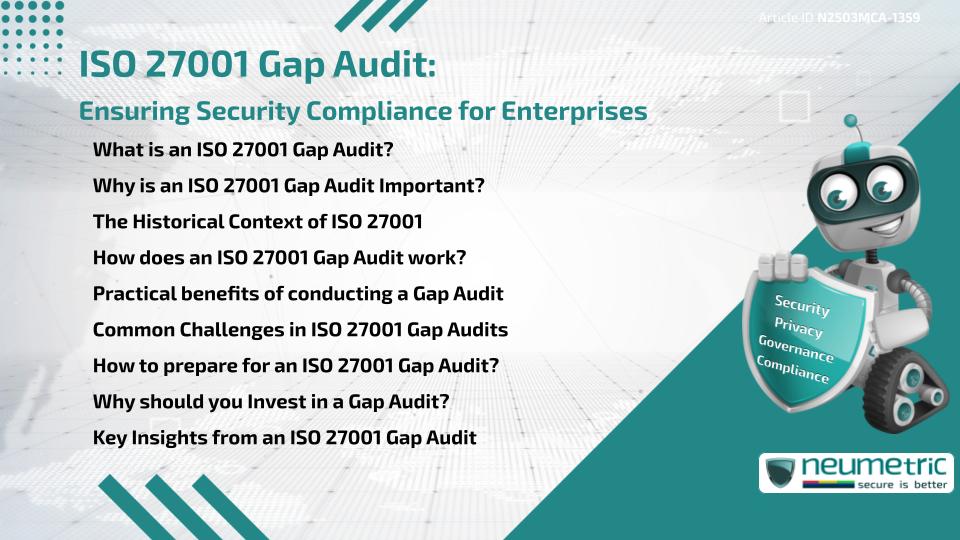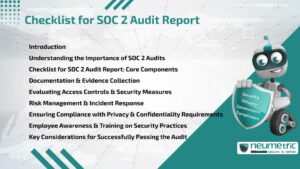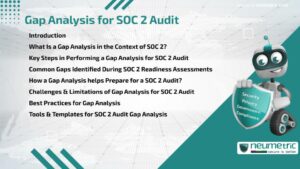Table of Contents
ToggleIntroduction
As Businesses increasingly prioritise Cybersecurity, understanding & achieving ISO 27001 Compliance is essential. An ISO 27001 Gap Audit plays a pivotal role in this process, helping Enterprises assess the differences between their current Security Practices & the ISO 27001 Standard. This Audit uncovers any Gaps, offering a Roadmap for achieving Full Compliance with the Globally Recognised Information Security Management System [ISMS] Standard. In this article, we will explore the importance of the ISO 27001 Gap Audit, its historical context, practical applications & how Enterprises can leverage it to enhance their Security Posture.
What is an ISO 27001 Gap Audit?
An ISO 27001 Gap Audit is an evaluation conducted by an Internal or External Auditor to assess an Organisation’s current Security Controls against the ISO 27001 Standard. The Audit identifies areas of Non-Compliance, Weaknesses in existing Controls & Opportunities for Improvement. By identifying these Gaps, Businesses can implement the necessary changes to align their systems with ISO 27001, ensuring their Security Practices meet International Standards.
Why is an ISO 27001 Gap Audit important?
ISO 27001 is recognised as a leading standard for managing Information Security Risks. However, achieving Compliance can be challenging, especially if an Organisation has not yet implemented a formal Information Security Management System [ISMS]. A Gap Audit provides a clear picture of an Enterprise’s Security Landscape, pinpointing areas where practices fall short. Without this Audit, Organisations might miss Critical Vulnerabilities that could lead to Breaches or Regulatory Fines.
The Historical Context of ISO 27001
ISO 27001, initially published in 2005, is part of a series of ISO standards that focus on Information Security. Over the years, the standard has evolved to address new & emerging Security Threats. The introduction of the Gap Audit process was designed to help Organisations navigate the complexities of the standard & pinpoint areas where their systems are not Fully Compliant.
Historically, Information Security was often reactive, with Organisations focusing on fixing breaches rather than preventing them. ISO 27001 shifted this perspective to proactive Risk Management, requiring Organisations toEstablish, Implement & Maintain an ISMS that is continuously Reviewed & Improved.
How does an ISO 27001 Gap Audit work?
An ISO 27001 Gap Audit typically follows a structured process to ensure all areas of Compliance are assessed. Here is how it generally works:
- Initial Assessment: The Audit begins with a high-level review of the Organisation’s current Security Controls & Practices.
- Detailed Gap Analysis: The Auditor compares Existing Systems & Processes against the Requirements of ISO 27001, Identifying any Gaps in the ISMS Framework.
- Reporting Findings: The Auditor provides a Report detailing Non-Compliance Areas, Vulnerabilities & Recommended Actions.
- Remediation Plan: Based on the Findings, the Organisation creates an Action Plan to address the Identified Gaps.
Practical benefits of conducting a Gap Audit
By identifying gaps early on, Organisations can prioritise Corrective Actions. Here are a few practical benefits:
- Risk Mitigation: A Gap Audit helps mitigate the Risk of Data Breaches & Security Incidents by ensuring that critical Security Measures are in place.
- Regulatory Compliance: Achieving ISO 27001 Compliance ensures that a Business meets the Regulatory Requirements of various Industries, reducing the Risk of Legal & Financial Penalties.
- Customer Trust: ISO 27001 Certification enhances Customer confidence, showing that an Organisation is serious about safeguarding Sensitive Data.
Common Challenges in ISO 27001 Gap Audits
While the benefits of conducting an ISO 27001 Gap Audit are clear, Enterprises may face several challenges during the process. One of the most common obstacles is the sheer complexity of the ISO 27001 Standard. The requirement for an ISMS to cover all aspects of Information Security from Physical Security to Human Resources & Technology, which can be overwhelming for Businesses with limited resources.
Additionally, the Audit process itself can be time-consuming & may require External Expertise, especially for Smaller Organisations without dedicated Compliance Teams. Finally, some Businesses may struggle to allocate the necessary Budget & Personnel to implement the changes recommended by the Gap Audit, which can delay the Compliance process.
How to prepare for an ISO 27001 Gap Audit?
Preparation is key to ensuring a smooth & successful Audit. Here are some steps Businesses can take to get ready:
- Understand the Standard: Familiarise your Team with the requirements of ISO 27001, focusing on areas that are most relevant to your Organisation.
- Conduct an Internal Assessment: Before the Gap Audit, perform an Internal Review of your Security Practices to identify potential weaknesses.
- Engage Stakeholders: Ensure that key Stakeholders which include Senior Management & IT Teams, are involved in the Audit process.
- Document Security Policies: Ensure that all Security Policies & Procedures are documented, approved & up to date, as Auditors will examine these Documents during the Audit.
Conclusion
An ISO 27001 Gap Audit is a critical step for any Organisation looking to achieve ISO 27001 Certification. By identifying gaps between current Security Practices & the Standard, Businesses can take proactive measures to improve their Information Security Management Systems. While the Audit process can present challenges, the benefits of enhanced Security, Regulatory Compliance & Customer Trust make it an invaluable tool for Enterprises in today’s changing landscape.
Takeaways
- An ISO 27001 Gap Audit helps Organisations identify areas where their Security Practices fall short of ISO 27001 Standards.
- It provides a Roadmap for improving Information Security Management Systems, reducing Risks & ensuring Compliance.
- The Audit process involves assessing Current Practices, identifying Gaps, reporting Findings & creating an Action Plan.
- Preparation is key to a successful Gap Audit & engaging Stakeholders from across the Organisation will ensure smooth execution.
FAQ
What is the difference between an ISO 27001 Gap Audit & a Full ISO 27001 Audit?
An ISO 27001 Gap Audit is a Preliminary Assessment to identify Gaps in Security Practices compared to the ISO 27001 Standard, while a Full Audit evaluates an Organisation’s overall Compliance.
How long can an ISO 27001 Gap Audit take?
The duration of an ISO 27001 Gap Audit depends on the size & complexity of the Organisation but usually takes between a few days & a couple of weeks to complete.
Can I conduct an ISO 27001 Gap Audit In-house?
Yes, an Internal Audit can be performed, but many Organisations prefer to engage External Auditors who bring expertise & an impartial perspective.
What happens after an ISO 27001 Gap Audit?
After the Audit, Businesses are provided with a Report detailing the areas where they need to improve & can then create a Remediation Plan to address those Gaps.





